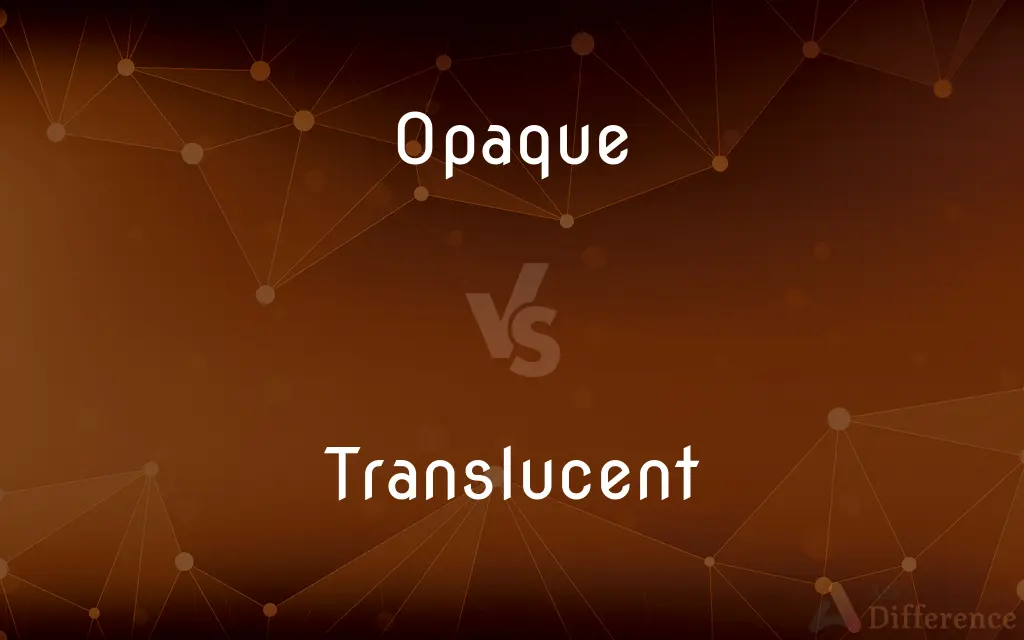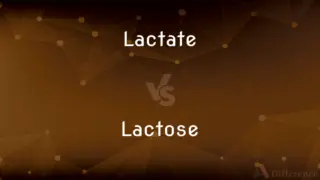Opaque vs. Translucent — What's the Difference?
Edited by Tayyaba Rehman — By Urooj Arif — Updated on April 27, 2024
Opaque materials block light completely, preventing any see-through, while translucent materials allow some light to pass but not detailed shapes.

Difference Between Opaque and Translucent
Table of Contents
ADVERTISEMENT
Key Differences
Opaque objects are completely impervious to light, meaning no light can pass through; this quality is essential in items like curtains that provide privacy. On the other hand, translucent materials, such as frosted glass, allow light to filter through but obscure the transmission of images, offering a balance between light and privacy.
In terms of materials, metals and stones are typically opaque, absorbing or reflecting all light. Conversely, materials like wax paper or tinted glass are translucent, permitting partial light transmission but blocking clear sight through them.
Opaque substances are favored in applications requiring complete light blockage, such as in the manufacturing of electronics enclosures or in certain types of packaging. Translucent substances are used where light is necessary but direct visibility is not, such as in lamp shades or bathroom windows.
The aesthetic value of opaque materials is in their ability to provide bold, solid colors which are used effectively in design and art. Whereas, translucent materials offer a soft, light-diffusing effect that is preferred in creating ambiance or mood lighting.
In photography and cinematography, opaque materials are used to prevent unwanted light, ensuring controlled lighting conditions. Translucent materials, however, are utilized to soften the lighting, helping in the creation of a more natural or gentle visual effect.
ADVERTISEMENT
Comparison Chart
Light Transmission
No light passes through.
Some light passes through.
Visibility Through Material
Completely blocks visibility.
Allows light but not detailed visibility.
Common Uses
Wall paints, doors, blackout curtains.
Frosted glass, lamp shades.
Material Examples
Metal, wood, dense fabrics.
Wax paper, frosted glass, thin plastics.
Aesthetic Impact
Provides boldness and solidity in colors.
Creates softness and diffuses light.
Compare with Definitions
Opaque
Not transparent.
Opaque tights are perfect for cold weather.
Translucent
Allowing light to pass through diffusely.
Her translucent umbrella showcased the colors of the rainbow.
Opaque
Hard to understand.
The text was opaque and difficult to interpret.
Translucent
Partially transparent.
The translucent curtains diffused the bright sunlight.
Opaque
Not reflecting light.
The artist chose an opaque black paint to absorb light in his artwork.
Translucent
Not completely clear or transparent.
The glass was translucent, blurring the figures behind it.
Opaque
Impervious to light.
The wall was opaque, blocking all sunlight.
Translucent
Frosted appearance.
The shower door was translucent for privacy.
Opaque
Not transmitting radiation.
The opaque container kept the film safe from x-rays.
Translucent
Semi-transparent quality.
The bottle was made of a translucent plastic.
Opaque
Impenetrable by light; neither transparent nor translucent.
Translucent
Transmitting light but causing sufficient diffusion to prevent perception of distinct images.
Opaque
Not reflecting light; having no luster
An opaque finish.
Translucent
Allowing light to pass through, but diffusing it.
Opaque
Impenetrable by a form of radiant energy other than visible light
A chemical solution opaque to x-rays.
Translucent
Clear, lucid, or transparent.
Opaque
So obscure as to be unintelligible
"opaque, elusive, minimal meanings" (John Simon).
Translucent
Transmitting rays of light without permitting objects to be distinctly seen; partially transparent.
Opaque
Mentally obtuse; dense.
Translucent
Transparent; clear.
Replenished from the cool, translucent springs.
Opaque
Something that is opaque, especially an opaque pigment used to darken parts of a photographic print or negative.
Translucent
Almost transparent; allowing light to pass through diffusely;
Translucent amber
Semitransparent curtains at the windows
Opaque
Neither reflecting nor emitting light.
Opaque
Allowing little light to pass through, not translucent or transparent.
Opaque
(figuratively) Unclear, unintelligible, hard to get or explain the meaning of.
Opaque
(figuratively) Obtuse, stupid.
Opaque
(computing) Describes a type for which higher-level callers have no knowledge of data values or their representations; all operations are carried out by the type's defined abstract operators.
Opaque
An area of darkness; a place or region with no light.
Opaque
Something which is opaque rather than translucent.
Opaque
(transitive) To make, render (more) opaque.
Opaque
Impervious to the rays of light; not transparent; as, an opaque substance.
Opaque
Obscure; not clear; unintelligible.
Opaque
That which is opaque; opacity.
Opaque
Not clear; not transmitting or reflecting light or radiant energy;
Opaque windows of the jail
Opaque to X-rays
Opaque
Not clearly understood or expressed
Common Curiosities
Why choose opaque materials in photography?
They are used to control light and prevent unwanted reflections.
Are all plastics translucent?
No, plastics can be opaque, translucent, or transparent depending on their composition.
What makes a material translucent?
Structural composition that scatters light but doesn’t block it completely.
How does translucency affect room ambiance?
Translucent materials can soften light, enhancing the room's mood.
What is the best material for light-blocking curtains?
Opaque materials, such as heavy fabrics, are best for light-blocking.
Can opacity be chemically altered?
Yes, through coatings and additives that adjust light transmission.
What defines a material as opaque?
Opaque materials do not allow any light to pass through.
Can translucent materials be used for privacy?
Yes, because they blur details while allowing light.
Is glass naturally translucent?
Glass can be processed to be clear, translucent, or opaque.
How are opaque materials used in packaging?
They protect the contents from light and maintain privacy.
Can opacity affect thermal insulation?
Yes, more opaque materials often provide better insulation.
Is translucency the same as transparency?
No, translucency allows light but obscures forms, unlike transparency.
What are the benefits of using translucent materials in design?
They provide light diffusion and a unique aesthetic quality.
Share Your Discovery

Previous Comparison
Pufferfish vs. Blowfish
Next Comparison
Lactate vs. LactoseAuthor Spotlight
Written by
Urooj ArifUrooj is a skilled content writer at Ask Difference, known for her exceptional ability to simplify complex topics into engaging and informative content. With a passion for research and a flair for clear, concise writing, she consistently delivers articles that resonate with our diverse audience.
Edited by
Tayyaba RehmanTayyaba Rehman is a distinguished writer, currently serving as a primary contributor to askdifference.com. As a researcher in semantics and etymology, Tayyaba's passion for the complexity of languages and their distinctions has found a perfect home on the platform. Tayyaba delves into the intricacies of language, distinguishing between commonly confused words and phrases, thereby providing clarity for readers worldwide.














































